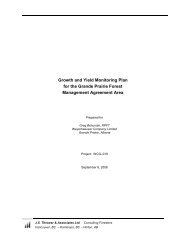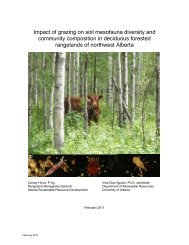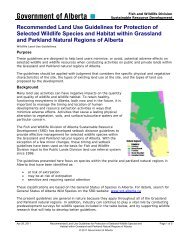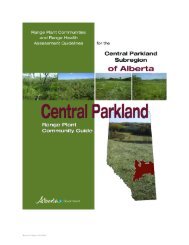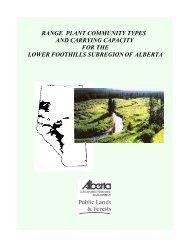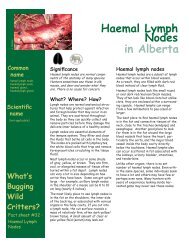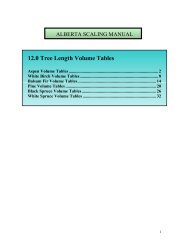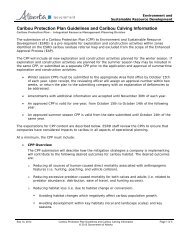Foothills Fescue Range Plant Community Guide - Sustainable ...
Foothills Fescue Range Plant Community Guide - Sustainable ...
Foothills Fescue Range Plant Community Guide - Sustainable ...
Create successful ePaper yourself
Turn your PDF publications into a flip-book with our unique Google optimized e-Paper software.
Carscallen and Greg McAndrews, ASRD, Calgary, Alan Robertson (High <strong>Range</strong><br />
Ecological Consultants), Varge Craig (Alta <strong>Range</strong>land Services Ltd.) and Tony Brierley<br />
(Agriculture and Agri-Food Canada) have contributed much to the review and<br />
refinement of this document and their assistance is greatly appreciated.<br />
Development of plant community guides for the Grassland Natural Region has been<br />
possible because of large and growing body of high quality vegetation plot data collected<br />
by <strong>Range</strong> Management program staff and a number of rangeland consultants since 1986<br />
when the Southern <strong>Range</strong> Inventory project was established, primarily to collect range<br />
plant community information for management planning. These professionals have payed<br />
particular care and attention to accurate plant taxonomy and consistent application of<br />
inventory methods. We wish to acknowledge the high quality of range vegetation<br />
inventory data that has been collected for the Public Lands Division by Kathy and Clare<br />
Tannas (Eastern Slopes <strong>Range</strong>land Seeds, Cremona, AB), Alan Robertson (High <strong>Range</strong><br />
Ecological Consultants, Edmonton, AB) and Bryne Weerstra (Biota Consultants,<br />
Cochrane, AB).<br />
Thanks to Dr. Walter Willms and Dr. John Dormaar, Agriculture and Agri-Food Canada<br />
for their friendship and constant encouragement. Thanks also to Francis Gardner,<br />
Gordon Cartwright and Jack Vandervalk for their years of patient teaching about foothill<br />
grasslands, their many values and management.<br />
Comments on the Second Approximation<br />
The second approximation adds an additional 10 plant communities to the original 20 in<br />
the first approximation. This classification provides an initial plant community guide to<br />
provide basic standards for assessing range health using the new range health assessment<br />
protocol (Adams et. al 2003). The first approximation guides in the Grassland Natural<br />
Region provide plant community information in a similar format to the plant community<br />
guides developed by Willoughby et. al (2003) for Boreal and Rocky Mountain natural<br />
regions thus ensuring a more standardized format province wide.<br />
A new feature of guides in the Grassland Natural Region will be an improved framework<br />
for correlating soils information to range site and plant community. A strength of the<br />
original stocking guide (Smoliak et. al 1966, Wroe et. al 1988) was the use of generic<br />
range sites definitions that allowed users to recognize site potential. The new system<br />
builds on the old framework but provides more objectivity in determining range site.<br />
Recently Thompson and Hansen (2002) have classified riparian and wetland plant<br />
communities in the Grassland Natural Region. The 3 rd approximation of this guide will<br />
integrate their riparian plant community types as a new research project provides soil<br />
correlation guidelines for riparian landscapes in the Grassland Natural Region.<br />
-vii-



